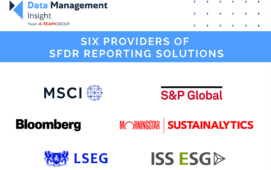
By Alexander Dorfmann, senior product manager at SIX.
Ever get the feeling that the surging interest in ESG poses more complex questions than straightforward answers for financial institutions? An interesting sub-plot to the revised Basel III agreement, now pushed out until 2025 due to the pandemic, is that rule makers will have new powers to assess environmental risks as part of regular reviews to ensure banks are following the script on ESG.
The European Commission has even asked the European Banking Authority to assess exactly how capital requirements might be lowered depending on the environmental and social impact of all assets held by financial institutions. We have a strong enough understanding of what ESG investment could be, despite gaps in global financial and regulatory standards, that regulatory bodies and industry groups are trying to fill.
The question is, do we have a deep enough comprehension and the appropriate data to correctly qualify and quantify this in terms of financial structures and regulatory capital relief?
In principle, capital relief for exposures to sustainable assets sounds all well and good. However, in practice, are banks really in a position to provide hard empirical evidence that they are less risky than non-green assets? You can only build, test and validate risk models on accurate data and without this there is potential for inaccurate risk assessment, which could result in unforeseen losses.
It is no good relaxing capital rules for sustainable assets if the information and regulatory data underlying these investments is so expensive to manage that the cost benefits are immediately wiped out. The issue is that many banks, large and small, have invested millions into data processes and are currently still sitting on old clunky tech infrastructure that requires significant amounts of human intervention. The astronomical operational costs of keeping the IT lights on alone is likely to offset any easing of capital restrictions underpinning ESG investments.
With this in mind, the reality is that a vast number of global and regional banks are currently in no position to accurately validate the data underpinning their ESG investments. If capital reliefs are to come into force, then financial institutions need to start posing some key questions right now.
As a case in point, how does one switch non-green investments on the books for the next decade over to green investments? Also, if a bank needs to bake in capital reliefs onto the current balance sheet, how do they know how this will directly affect the capital underpinning the other assets that they hold? A major financial institution can, of course, much more easily securitise its current loan book than a smaller regional bank, for instance.
This will once again raise the concern that credit facility constraints will increase while there will be more demand to further broaden the refinancing instruments for SMEs (small and medium enterprises). The reality is that with capital markets going increasingly digital, institutional, professional and retail investors are seeking “green” investments meaning that traditional refinancing sources for SMEs may dry out. How these SMEs can access liquidity, especially if an investment is qualified as non-ESG, is still uncertain.
If financial institutions, of all sizes, harbour any hopes of finding answers to these questions then they should be looking to lean on their data providers to ensure their ESG data is ready for consumption. Financial institutions will need as much data from different sources as possible, including alternative data sources, to ensure they are not over or undershooting on the amount of capital they need to hold in reserve.
This will, in turn, help to navigate the ESG landscape and enable them to prove the long-term value of their investment decisions leading to less regulatory capital and liquidity requirements.
While it is positive to see rule makers explore the relaxation of capital rules to encourage more sustainable investments to the market, a number of data issues need to be considered as financial institutions mull over how to prepare their balance sheets for the potential easing of ESG capital restrictions.
With no definitive timetable for the integration of sustainability risks into the capital requirements, financial institutions could be forgiven for not knowing where to start. One thing is for certain though; the sourcing of high-quality and ESG data is fundamental, regardless of the precise amount of capital that will need to be held in reserve. This is paramount to ensuring firms unquestionably prove to investors the sustainability of their products and decisions.
Subscribe to our newsletter




